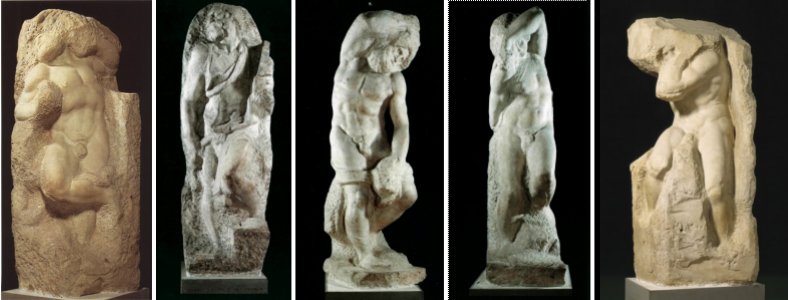What is the difference between a lump of rock and a sculpture by Michelangelo? They are made from the same material - Michelangelo has just taken some of that material away. These are examples of unfinished sculptures by Michelangelo. They were commissioned in 1505 but were never completed instead human forms try to burst out of the rock. The delicate nature of Michelangelo's sculpture contrasts with the solid form of the natural rock.
Bill Woodrow 'Twin-Tub with Guitar' 1981
This odd conjunction brings together two symbols of Western consumerism. Woodrow explained ‘The guitar was a pop icon and the washing machine was an everyday, domestic item. So it was bringing the two things together like a slice of life’.
Traditionally a sculpture transforms a material - A tree into a carving, a rock into a horse or clay moulded into a figure. The sculpture Bill Woodrow believes that any material has the potential to become something else. Bill Woodrow’s raw materials are familiar, domestic objects collected from the streets and junk yards in his neighbourhood. In the early 1980s he began giving them new meanings by peeling back their outer casing to form new objects. Here he has cut a sculpture of an electric guitar from a discarded Hotpoint washing machine.
Brian Griffiths 'The body and ground (or your lovely smile)' 2010
Brian Griffiths sculptures are made from a variety of everyday materials. This above sculpture is from the British Art Show at the Hayward Gallery, London. It is made from - Canvas, scenic paint, ropes, webbing, fiberglass poles, vintage travel souvenir patches, net fabric, tarpaulin, duct tape, thread, string, concrete blocks and fixings. These materials have been brought together to create a form that make us think of a teddy bear or Mickey mouse.
still from 'The science of sleep' dir. Michel Gondry
Michel Gondry is a director who creates strange disjointed films - 'The Science of Sleep', 'Be Kind Rewind' along with adverts and music videos. He has created props and sets out of cardboard and made videos out of lego.
A photograph transforms the three dimensional world around us into a flat two dimensional image frozen in time.
A painting is matter moulded and manipulated on a surface to create form and colour
M.C. Esher
Wander Wulz
M.C. Esher
M.C. Escher will often transform one image into another - in this example a bird transforms into a fish.
Wander Wulz
In this photomontage or sandwich negative Wander Wulz has merged herself with the image of a cat. This image was produced in the dark room and partly achieved by sandwiching two negative together to create a composite image.
The notion of person turning into an animal is famously used in The Metamorphosis a novella by Franz Kafka.
Rene Magritte 'The Explanation' 1954
Renne Magritte 'le modele rouge' 1935
These images by Rene Magritte show how he would juxtapose two images to create a new strange image. A carrot becomes a bottle or shoes become feet. Magritte was a Surrealist who were interested in dreams and the unconscious. In a dream you will combine everyday things but by combining them they become strange. You may dream of a hat or a piece of cheese - both very ordinary. However, in your dream they appear to you as a hat made out of cheese - this is an element of surrealism.
Man Ray 'Cadeau' 1921
By adding a row of nails, Man Ray transformed a household flat-iron into a new and potentially threatening object. The nails and burning metal suggest a violent object at odds with the work’s title, the French word for ‘gift’. The original version, given to the composer Eric Satie, was lost but became well-known through Man Ray’s photograph of it. Although made at the height of Paris Dada Cadeau, like Man Ray’s other objects, anticipated the exposure of hidden desires found in subsequent Surrealist objects.
Meret Oppenheim 'object' 1936
This Surrealist object was inspired by a conversation between Oppenheim and artists Pablo Picasso and Dora Maar at a Paris cafe. Admiring Oppenheim's fur-covered bracelet, Picasso remarked that one could cover anything with fur, to which she replied, "Even this cup and saucer." Soon after, when asked by André Breton, Surrealism's leader, to participate in the first Surrealist exhibition dedicated to objects, Oppenheim bought a teacup, saucer, and spoon at a department store and covered them with the fur of a Chinese gazelle.













